Elections 2024: What is ECP's Election Management System and how does it work?
ECP is adopting all necessary measures to ensure transparent and fair mechanism for management of poll results
January 30, 2024
With the February 8 general elections drawing closer by the day, the Election Commission of Pakistan (ECP) is adopting all necessary measures to ensure a transparent and fair mechanism for the management of poll results, slated to be held on February 8 across the country.
In this regard, the electoral body has developed a result compilation mechanism called "Election Management System (EMS)" to avoid a repeat of 2018.
Being touted as one of the most crucial yet controversial elections in the country, owing to the concurrent economic and political instability, the upcoming polls will be conducted more than five years after voters in Pakistan exercised their right to elect public representatives in the previous general polls.
The 2018 elections, however, like many polls in the past, were marred by controversies, particularly those surrounding the management, compilation and transmission of results, casting doubts about the transparency and accuracy of the electoral body's handling of votes.

The ECP, during the 2018 general elections — that saw the arrival of the Imran Khan-founded Pakistan Tehreek-e-Insaf (PTI) forming their government in the centre with majority votes — utilised its Results Transmission System (RTS). The system, however, suffered a "technical glitch", as communicated by the electoral body back then, eventually delaying the announcement of election results that the public had been waiting for with bated breath.
The delay, therefore, drew immense ire from the competing political parties in the wake of which the 2018 elections remained contentious and were termed "RTS elections".
This time around, however, the ECP is taking steps to ensure that the upcoming polls and the subsequent counting of votes cast during the ballot remain undisputed.

What is the Election Management System?
To guarantee the accuracy and transparency of the process, the electoral authority has introduced its Election Management System (EMS) — an automated and modern management system developed for the tabulation, transmission, compilation and tabulation of election results.
However, the performance of the EMS will only be gauged on February 8 for which the ECP had conducted a mock exercise last week.
The programme will be utilised at a total of 90,675 polling stations with 276,402 polling booths for more than 128 million voters who will be electing their representatives on the said day.
In Punjab, 50,944 polling stations will be established for the general elections, followed by 19,006 in Sindh, 15,697 in Khyber Pakhtunkhwa and 5,028 in Balochistan.
The returning officers (ROs) have already certified and completed Forms 28 and 33 in the system, while the presiding officers have also been mapped to polling stations by January 25.
The two forms contain details about candidates as well as the number of polling stations across all constituencies.

After the polling is completed, the ROs will ask the presiding officers to start sending the result of one to two pages of each National Assembly and provincial assembly constituency from their EMS mobile application by taking a snapshot.
To ensure uninterrupted connectivity, according to reports, the EMS ecosystem is designed to operate over a private secure network in case of unavailability of mobile data or WiFi.
The ROs will be provided with a Form 45. The EMS operators will start entering the results' data until the completion of the data entry of Form-45.
On completion of Form-45 data entry, the ROs will generate Form 47. After this, the presiding officers are directed to provide a signed copy of Form 45 to the candidates' polling agents.
As per the ECP guidelines, the RO must compile the results sent by the presiding officers (POs) by 2am.
The ROs are then required to hand over the results in the presence of all candidates and also complete forms 47, 48, and 49 for results before sealing them.
The RO is also bound to send scanned copies of the forms to the electoral authority immediately, as well as original copies as soon as they can.
Once this entire process is complete, the Election Commission must notify the final result within 14 days after the election.
With additional input from Geo Election Cell.











